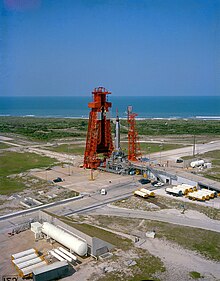
Back Launch Complex 14 German Συγκρότημα εκτοξεύσεων 14 Greek Cape Canaveral AFS LC-14 Finnish Complexe de lancement 14 French Cape Canaveral Space Force Station Lanceercomplex 14 Dutch Štartovací komplex 14 na Cape Canaveral Space Force Station Slovak 卡纳维拉尔角空军基地14号发射台 Chinese
 Aerial view of Mercury-Atlas 9 at LC-14 in 1963 | |||||||||||
 | |||||||||||
| Launch site | Cape Canaveral Space Force Station | ||||||||||
|---|---|---|---|---|---|---|---|---|---|---|---|
| Location | 28°29′28″N 80°32′49″W / 28.49111°N 80.54694°W | ||||||||||
| Time zone | UTC−05:00 (EST) | ||||||||||
• Summer (DST) | UTC−04:00 (EDT) | ||||||||||
| Short name | LC-14 | ||||||||||
| Operator | United States Space Force (owner) Stoke Space (tenant) | ||||||||||
| Total launches | 32 | ||||||||||
| Launch pad(s) | 1 | ||||||||||
| Orbital inclination range | 28° – 57° | ||||||||||
| |||||||||||
Active pads
Inactive leased pads
Inactive unleased pads
1
LC-39B2
LC-39A3
LC-484
SLC-415
SLC-406
LC-477
SLC-378
LC-349
SLC-2010
LC-1911
LC-1612
LC-1513
LC-1414
LC-13 (LZ-1 & LZ-2)15
LC-1216
LC-1117
LC-3618
LC-1, LC-2, LC-3, and LC-419
SLC-4620
LC-21 and LC-2221
LC-31 and LC-3222
LC-1823
SLC-1724
LC-2625
LC-5 and LC-626
LC-3027
LC-2528
LC-29Launch Complex 14 (LC-14) is a launch site at Cape Canaveral Space Force Station in Florida. Part of the Missile Row lineup of launch sites in the region, LC-14 was used for various crewed and uncrewed Atlas launches, including the February 1962 Friendship 7 flight aboard which John Glenn became the first American to orbit the Earth.[1][2]
LC-14 is currently leased to Stoke Space for their Nova launch vehicle.
- ^ "Cape Canaveral Space Force Museum". ccspacemuseum.org. Retrieved 2024-07-23.
- ^ "LAUNCH COMPLEX 14 FACT SHEET | Spaceline". Retrieved 2024-07-23.
